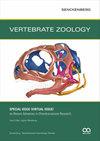The turbinal skeleton of Pentalagus furnessi (Leporidae, Lagomorpha)
IF 2.4
2区 生物学
Q1 ZOOLOGY
引用次数: 0
Abstract
The turbinal skeleton inside the nasal cavity supports the respiratory and olfactory epithelia of the mammalian nose and can provide systematic and morphofunctional information. For the first time, the turbinal skeleton of Pentalagus furnessi (Amami rabbit) from Japan is described based on µCT scans and virtual 3D reconstructions of two specimens. In general, the turbinal skeleton of Pentalagus furnessi resembles the pattern and characters observed in other Leporidae. The maxilloturbinal is highly dendritic, nasoturbinal and crista semicircularis are in close contact and form a common recess, the frontoturbinal recess houses two frontoturbinals and one interturbinal between them, the ethmoturbinal recess houses three ethmoturbinals and one interturbinal between ethmoturbinal I and II. Pentalagus furnessi is derived from the leporid grundplan in having a lamina semicircularis with almost straight posterior margin and ventral lamella and in showing a single-scrolled and relatively short interturbinal between frontoturbinal 1 and 2. These characters can be regarded as autapomorphic for the Amami rabbit. Furthermore, the two specimens have an additional small and short interturbinal between frontoturbinal 2 and ethmoturbinal I that shows some variation. This pattern supports previous observations of intraspecific variation of certain interturbinals in Oryctolagus cuniculus and some Sylvilagus and Lepus species. The comparison of the turbinal skeleton of Pentalagus furnessi and its possible sister taxon (e.g., Pronolagus, Poelagus or Caprolagus) reveals a puzzling pattern which is discussed.卷尾鱼的鼻甲骨骼
鼻腔内的鼻甲骨骼支持哺乳动物鼻子的呼吸和嗅觉上皮,并可以提供系统和形态功能信息。基于两个标本的µCT扫描和虚拟3D重建,首次描述了来自日本的Pentalagus furnessi(阿玛米兔)的鼻甲骨骼。一般来说,卷尾猴的鼻甲骨骼与其他鳞翅目的模式和特征相似。上颌窦高度树枝状,鼻鼻甲和半圆形嵴紧密接触并形成一个共同的隐窝,前涡轮隐窝容纳两个前涡轮和它们之间的一个涡轮间,乙涡轮隐窝包含三个乙涡轮和一个乙涡轮I和II之间的涡轮间。弗氏Pentalagus furnessi源于鳞翅目粗平面,具有几乎笔直的后缘和腹侧片层的半圆形片层,并且在前涡轮机1和2之间显示出单个滚动且相对较短的涡轮机间叶。这些特征可以被认为是阿玛米兔的自变形特征。此外,这两个样本在前涡轮机2和后涡轮机I之间有一个额外的小而短的涡轮机间,显示出一些变化。这一模式支持了先前对楔形Oryctolagus和一些Sylvilagus和Lepus物种中某些涡轮机间物种的种内变异的观察。对弗内西五爪虫的鼻甲骨架与其可能的姐妹分类单元(例如,前叉虫、坡氏虫或卡普罗拉虫)的比较揭示了一种令人困惑的模式,对此进行了讨论。
本文章由计算机程序翻译,如有差异,请以英文原文为准。
求助全文
约1分钟内获得全文
求助全文
来源期刊

Vertebrate Zoology
ZOOLOGY-
CiteScore
4.00
自引率
19.00%
发文量
42
审稿时长
>12 weeks
期刊介绍:
Research fields covered by VERTEBRATE ZOOLOGY are taxonomy, morphology, anatomy, phylogeny (molecular and morphology-based), historical biogeography, and palaeontology of vertebrates.
 求助内容:
求助内容: 应助结果提醒方式:
应助结果提醒方式:


